5 Best Fence Lumber
- April 16, 2024
- 0 comment
When you’re setting up a new fence, picking the right wood is crucial. It affects how your fence looks, how long it lasts, and how much care it’ll need. This guide dives into the top wood choices for fences, explaining each one’s strengths and weaknesses. This way, you can pick the best option for your fencing project without any guesswork.
List of Best Fence Lumber:
1. Cedar
Cedar is highly prized for its distinct color and natural beauty. It emits a pleasant scent and contains oils that make it resistant to insects and decay. This wood type doesn’t require frequent staining due to its ability to withstand diverse weather conditions, aging gracefully into a charming silver-gray hue over time.
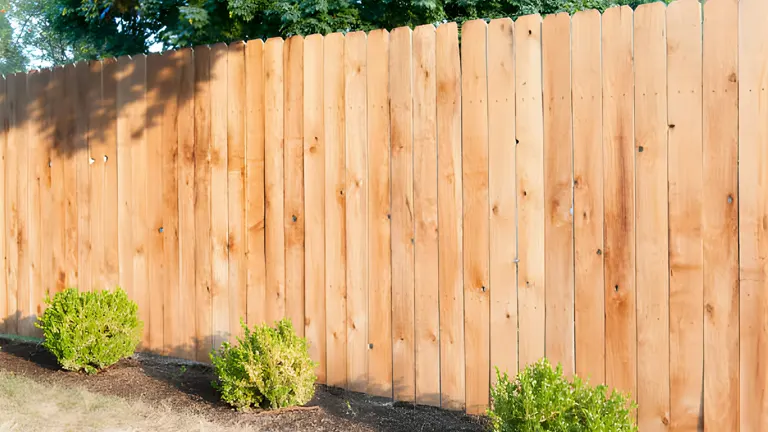
Although cedar is pricier compared to some other woods, its long lifespan and low maintenance requirements often justify the investment. It’s ideal for creating decorative fences that enhance the aesthetic appeal of a property without necessitating constant upkeep.
Pros
- Naturally beautiful with a rich color that can enhance the aesthetic of any property.
- Contains oils that repel insects and resist decay, increasing durability.
- Does not require staining and weathers to an attractive silver-gray finish over time.
Cons
- More expensive upfront compared to some other types of wood.
- Can be less available in certain regions, which may increase costs further.
Maintenance of Cedar Fence
Maintaining a cedar fence effectively involves annually cleaning it with a mild detergent and a soft brush to prevent mold and mildew, which preserves the wood’s integrity. It’s also important to apply a clear wood preservative every two to three years to shield the cedar from UV rays and moisture, helping to maintain its natural color and prevent graying. Regular inspections should be conducted to check for signs of wear like splintering or loose boards, with immediate repairs made to prolong the fence’s durability and aesthetic appeal.
2. Redwood
Redwood, akin to cedar in terms of visual allure, showcases a deep, rich color that many homeowners covet for premium fence projects. This wood type can be sealed to maintain its color, protecting it from fading.

It possesses a natural resistance to rot, decay, and insect infestation, making it suitable for regions with high moisture levels. Redwood’s durability and quality come at a higher cost but offer extended longevity, making it a worthwhile option for fences that aim to combine elegance with resilience.
Pros
- Offers a similar visual appeal to cedar but can retain its deep red color longer when properly sealed.
- Exceptionally resistant to rot, decay, and insects, making it ideal for damp climates.
- Long lifespan due to inherent durability.
Cons
- One of the more expensive wood options due to its superior qualities.
- Requires sealing to maintain color, adding to maintenance efforts.
Maintenance of Redwood Fence
To maintain a redwood fence, start by using a mild soap solution and a soft brush for gentle cleaning, ensuring all debris and stains are removed to prevent wood degradation. Protect the wood’s rich colors from the sun’s harsh effects by treating the fence with a UV-resistant sealant. Additionally, any cracked or damaged boards should be promptly replaced, and touch-up sealant should be applied to any cuts or holes to further guard against decay and extend the life of the fence.
3. Pressure-Treated Pine
This economical choice is popular among budget-conscious homeowners. Pressure-treated pine is infused with chemicals that fend off rot, decay, and termites.

It requires more upkeep, including regular staining or sealing to prevent moisture damage, which can be a consideration in its overall cost-effectiveness. Despite these maintenance needs, pressure-treated pine provides a durable fencing solution, especially in humid or wet climates where durability is a priority.
Pros
- Treated with chemicals to resist rot, decay, and termites, enhancing its durability.
- More affordable than cedar and redwood.
- Widely available and versatile for various construction needs.
Cons
- Chemical treatment may not be suitable for all environments or personal preferences.
- Requires regular maintenance like staining or painting to maintain durability and appearance.
Maintenance of Pressure-Treated Pine Fence
For proper maintenance of a pressure-treated pine fence, it is essential to allow the wood to weather for several months after installation. This waiting period ensures that the preservatives deeply infuse and stabilize within the wood, preparing it for further treatment. Once settled, apply a high-quality stain or paint to create a moisture barrier that enhances the fence’s resistance to rot and decay. It is advisable to reapply the protective coating every 3 to 5 years, depending on your local climate and the wear and tear from weather conditions. Additionally, regular inspections for termite damage or fungal growth are crucial, as even pressure-treated wood can succumb to these issues over time. Promptly addressing these signs by replacing affected sections and applying corrective treatments can help maintain the fence’s integrity and appearance.
4. Douglas Fir
Douglas Fir offers robustness and strength when treated with preservatives, though it’s less resistant to decay than cedar or redwood without treatment.
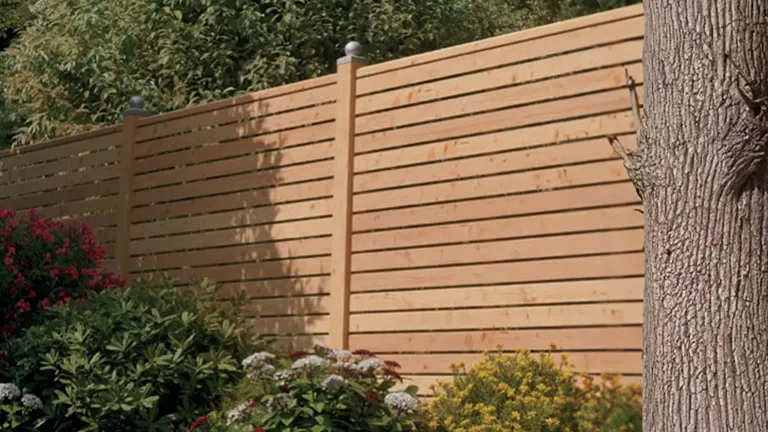
It holds paint and stains well, which is necessary to enhance its resistance against environmental elements. This wood is cost-effective and works well for large-scale projects where strength is essential but budget constraints are tight. It’s commonly used for utility fencing where functionality trumps aesthetic concerns.
Pros
- Strong and durable when treated, suitable for structural applications.
- More economical than cedar and redwood, making it accessible for larger projects.
Cons
- Requires regular maintenance, including painting or staining, to protect against decay.
- Less naturally resistant to decay and pests compared to cedar or redwood.
Maintenance of Douglas Fir Fence
To maintain a Douglas Fir fence effectively, start by treating the wood with a preservative prior to installation, unless it comes pre-treated. This step is crucial for enhancing the wood’s durability against weather conditions and pests. After the wood has been treated, apply an exterior-grade paint or stain to seal it, protecting it from moisture. This is particularly important for Douglas Fir, as it does not contain natural oils that other woods like cedar do. Annually check the fence for any peeling paint or stain, especially in the seams and joints where moisture is likely to penetrate. Addressing these issues promptly can prevent more significant damage, ensuring the longevity of the fence.
5. Cypress
Cypress features natural oils akin to those found in cedar, which help it resist insects and rot, contributing to its durability. The wood varies in color from tan to red, depending on its age.

While it can be on the expensive side, particularly outside its native Southeastern U.S. region, its longevity and reduced maintenance needs make it a valuable choice. Cypress is best suited for fences in areas where it is readily available and where long-lasting, low-maintenance barriers are preferred.
Pros
- Contains natural oils that provide resistance to rot and insects.
- Offers a unique tan to red hue that can vary beautifully depending on the wood’s age.
Cons
- Can be expensive and less available, especially outside of the Southeastern U.S.
- Variable quality depends on the source and age of the wood.
Maintenance of Cypress Fence
Maintaining a Cypress fence is relatively straightforward due to its natural insect and decay resistance, which minimizes the need for frequent interventions. To preserve its appearance and durability, it is beneficial to apply a water-repellent finish every few years. This helps prevent moisture absorption, which can lead to long-term damage. Regular cleaning with a soft brush and mild detergent is recommended to remove dirt and potential mildew buildup. Additionally, inspect the fence periodically for any physical damage or areas where moisture may accumulate, as addressing these issues promptly can extend the life of your fence.
Cost Comparison Chart for Fence Lumber
| Type of Wood | Initial Cost (per linear foot) | 10-Year Maintenance Cost | Total Cost Over 10 Years |
|---|---|---|---|
| Cedar | $3.50 – $5.00 | $250 – $350 | $600 – $850 |
| Redwood | $6.00 – $8.00 | $200 – $300 | $800 – $1100 |
| Pressure-Treated Pine | $1.50 – $2.50 | $450 – $600 | $600 – $825 |
| Douglas Fir | $2.00 – $3.50 | $600 – $800 | $620 – $1030 |
| Cypress | $4.00 – $6.00 | $300 – $400 | $700 – $1000 |
Explanation of Costs:
- Initial Cost: This is the average price per linear foot for each type of wood, which may vary based on your location and the specific retailer.
- 10-Year Maintenance Cost: This estimate includes costs associated with periodic staining, sealing, or painting required to maintain the integrity and appearance of the fence.
- Total Cost Over 10 Years: This figure sums up the initial cost with the estimated maintenance over a decade, providing a long-term perspective on your investment.
These figures are illustrative and based on market averages; actual costs can vary. Cedar and Redwood, while more expensive initially, offer lower long-term maintenance costs due to their natural durability and resistance to decay. Pressure-treated pine, although cheaper upfront, may incur higher maintenance costs, especially in harsh weather conditions. Douglas Fir is cost-effective for initial projects but requires significant upkeep. Cypress provides a good balance of durability and cost, particularly in regions where it’s readily available.
Alternatives to Wood
While wood remains a popular choice for fencing due to its natural appearance and traditional charm, there are several alternative materials worth considering, each with its own set of advantages.
Vinyl Fencing
Vinyl is known for its durability and low maintenance requirements. It doesn’t need painting or staining and can be cleaned easily with soap and water. Vinyl is also resistant to rot, insects, and weathering, making it a long-lasting option. However, it tends to be more expensive upfront than wood and may not have the same natural look that some homeowners desire.
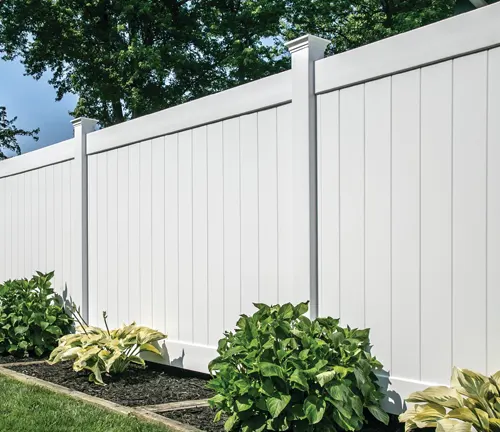
Composite Fencing
Made from a blend of wood fibers and plastic polymers, composite fencing offers the best of both worlds—the look of wood without the intensive maintenance. It is resistant to rot, fading, and insect damage. Composite materials are eco-friendly, often made from recycled materials. The cost can be higher than traditional wood, but the longevity and reduced maintenance can offset the initial investment over time.
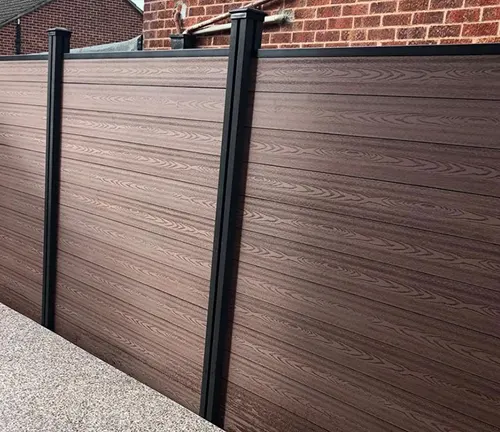
Metal Fencing
Choosing wood over these alternatives often comes down to aesthetic preference, cost considerations, and specific functional needs like privacy or security. Wood offers a warm, classic look that blends naturally with outdoor environments, making it a perennial favorite among those looking to enhance the traditional beauty of their homes. However, those prioritizing longevity and minimal upkeep might lean towards alternative materials.
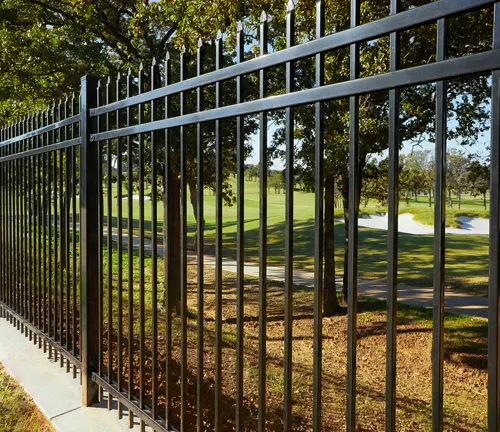
Conclusion
When choosing the best lumber for fence construction, considering the specific characteristics and costs of each wood type is essential. Cedar and redwood stand out for their natural beauty and resistance to decay and insects, making them excellent choices for decorative fences with minimal maintenance needs. Although these options are pricier, their durability often justifies the higher initial investment.
Pressure-treated pine offers a more budget-friendly alternative without sacrificing too much on durability, especially suitable for areas with high moisture or termite activity. However, it does require regular maintenance to maintain its integrity and appearance.
Douglas fir provides a sturdy option for utility fencing, particularly when treated with preservatives, although it requires consistent maintenance to preserve its condition against weather elements.
Cypress, while less common, offers excellent durability and natural resistance to insects and rot, making it a low-maintenance option in regions where it is readily available.
Ultimately, the choice of fence lumber should align with both aesthetic preferences and practical requirements, balancing initial costs against long-term maintenance and durability to find the most cost-effective and suitable option for your fencing needs.
FAQs
- What makes cedar and redwood preferred choices for fence lumber?
Cedar and redwood are highly prized for their natural resistance to decay, insects, and weather elements. Both woods also have a natural beauty, with rich colors that can enhance the aesthetic of any property. - Can pressure-treated pine last as long as cedar or redwood?
Pressure-treated pine can last a comparable length of time to cedar or redwood if properly maintained. Its longevity is enhanced by chemical treatments that resist rot, decay, and pest damage, though it requires regular staining or painting to maintain its condition. - Why might someone choose Douglas fir over more durable woods like cedar?
Douglas fir is chosen for its strength and lower cost compared to cedar and redwood. It’s especially suitable for painted or stained fences due to its ability to hold finishes well, making it a practical choice for budget-conscious homeowners who need durability without the higher price tag. - Is cypress fencing worth the extra cost?
Cypress is worth considering if you are looking for a durable and naturally beautiful wood that requires minimal maintenance. While it can be more expensive, especially outside the Southeastern U.S., its longevity and lower maintenance needs can provide better value over time. - How do the maintenance requirements differ between these wood types?
Each wood type requires different levels of maintenance. For example, cedar and redwood benefit from occasional cleaning and sealing to maintain their color and resist weathering. Pressure-treated pine requires more frequent painting or staining to protect against moisture. Cypress and Douglas fir generally need less maintenance but benefit from periodic checks and basic care. - What are the environmental impacts of using different types of fence lumber?
+The environmental impacts vary by wood type. Woods like cedar and redwood are often sourced from sustainably managed forests but can be more expensive and less available. Pressure-treated pine uses chemicals in its treatment process, which can be a concern for eco-conscious homeowners. Choosing local or sustainably sourced wood can mitigate some of these environmental concerns. - Are there non-wood alternatives that offer similar benefits to these traditional fence materials?
Yes, materials like vinyl, composite, and metal are viable alternatives to wood fencing. They offer various benefits such as reduced maintenance, longevity, and in some cases, better resistance to weather and pests. However, they might not provide the natural look and feel that wood offers.
We hope this guide helps you choose the perfect lumber for your fence project! Have you tried any of these woods, or do you have another favorite? Share your experiences or any additional questions in the comments below—we’d love to hear about what works for you and any tips you might have!

David Murray
Forestry AuthorI'm David Murry, a forestry equipment specialist with a focus on chainsaw operation. With over 13 years of experience, I've honed my skills in operating and maintaining a wide range of machinery, from chainsaws to log splitters. My passion for the outdoors and commitment to sustainable forestry drive my work, which emphasizes safety, efficiency, and staying updated with industry advancements. Additionally, I'm dedicated to sharing my expertise and promoting environmental awareness within the forestry community.













Leave your comment